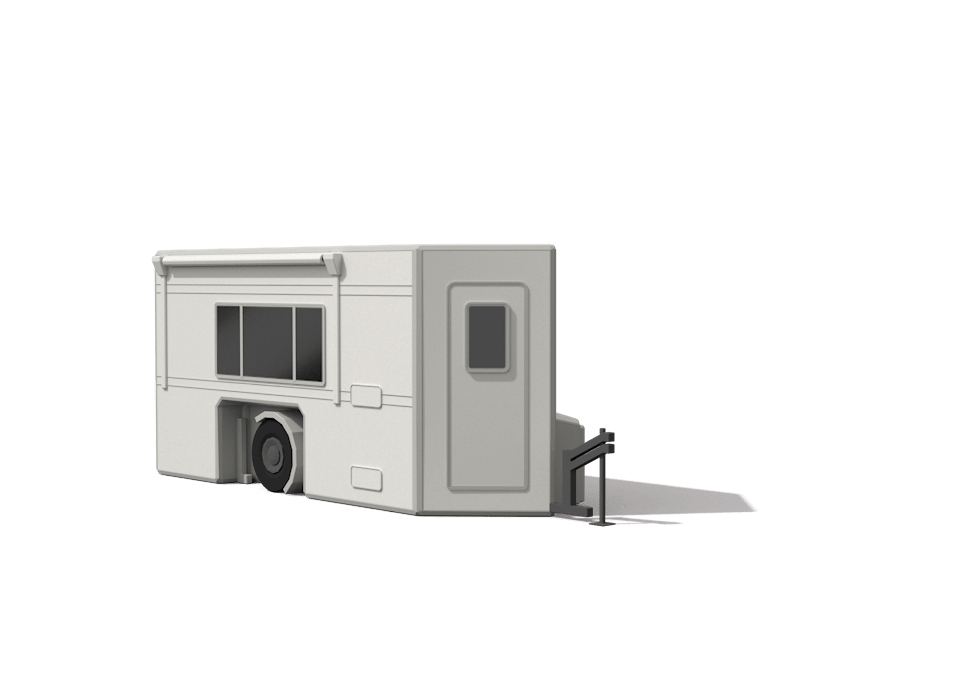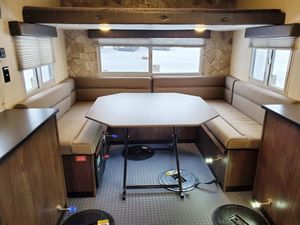The following information was provided to Go RVing courtesy of the Minnesota Department of Natural Resources. For more information on ice fishing safely, visit their website. For the story on this page about the Salzbruns, a park ranger checked the thickness of the ice and it was found to be 24 inches thick.
Ice Fishing in Minnesota
The Salzbrun family isn’t fazed by frigid temperatures—in fact, they embrace them. When most people are bundling up indoors, the Salzbruns are praying for subzero temperatures, hoping for ice thick enough to support their wintertime tradition: ice fishing from the comfort of their RV. For them, ice fishing isn’t just about catching fish—it’s about bonding as a family, creating memories, and experiencing the joy of the great outdoors, even in the coldest months.
For their daughter, Isabelle, who has cerebral palsy, an ice fishing RV provides a warm and accessible space, allowing her to fully participate in family adventures. With their ice house on wheels, the Salzbruns are able to combine their love for RVing and fishing, proving that outdoor adventures can be for everyone.
Whether you’re a seasoned angler or new to the world of ice fishing, a well-prepared RV setup can transform the experience, providing warmth and all the comforts of home. If you’re considering taking your RV out onto the ice, here’s everything you need to know to do it safely and successfully.
RELATED: What To Look for in an Accessible RV
How to Ice Fish Safely
Ice fishing is an exhilarating way to enjoy winter camping, but it requires careful planning and safety precautions. Ice conditions can vary dramatically, and understanding how to assess ice thickness and stability is crucial before venturing out.
Understanding Ice Thickness and Strength
Not all ice is created equal. Several factors—including temperature, water movement, and snow cover—affect the strength of ice. Here are a few key facts to keep in mind:
- New ice is stronger than old ice – Four inches of newly-formed, clear ice may support a person on foot, while older, partially-thawed ice may not be safe at all.
- Ice thickness can vary across a lake – It may be a foot thick in one spot but only an inch or two just a few feet away.
- Flowing water weakens ice – Be cautious near streams, bridges, and river bends where the current can undermine the ice.
- Snow can insulate and weaken ice – A heavy snow cover slows down the freezing process and adds weight, reducing how much weight the ice can support.
- Cracking ice doesn’t always mean danger – Booming and cracking sounds simply indicate the ice expanding and contracting due to temperature changes.
How Thick Should the Ice Be?
Before taking your RV, ATV, or even yourself onto the ice, check that it meets the recommended thickness for safety:
- Under 4 inches – Stay off the ice
- 4 inches – Safe for ice fishing on foot
- 5-7 inches – Safe for a snowmobile or ATV
- 8-12 inches – Safe for a small car or pickup truck
- 12-15 inches – Safe for a medium truck
If you’re dealing with white or "snow ice," which is only about half as strong as new, clear ice, double the recommended thickness for safety.
How to Check Ice Thickness
Before heading out, make sure to check the ice at multiple points to ensure consistency. Here are a few tools that can help:
- Ice Chisel – A sharp metal rod with a flat blade used to chip a hole into the ice.
- Ice Auger – Available in hand, electric, or gas-powered models, ice augers drill holes quickly and efficiently.
- Cordless Drill – A long, five-eighths inch wood auger bit can drill through ice in under 30 seconds.
- Tape Measure – Use a tape measure or an ice skimmer with inch markings to measure true ice thickness.
Bringing Your RV Onto the Ice
For those serious about ice fishing, an RV-style ice fishing house can take the experience to the next level. These specialized RVs are designed for winter camping and fishing, offering built-in holes in the floor to drop your line straight into the water while staying warm inside.
Key Considerations for Ice Fishing in an RV
- Ensure the ice is thick enough – Follow the thickness guidelines carefully before driving your RV onto the ice.
- Use a propane heater – Many ice fishing RVs come equipped with propane heating to keep the interior warm and comfortable.
- Monitor CO levels – Always use a carbon monoxide detector when using propane inside an RV.
- Anchor securely – High winds can be a concern on open ice. Use ice anchors to keep your RV in place.
- Have an emergency exit plan – Always know the safest route back to shore in case of sudden ice changes.
RELATED: Ice Fish Houses
Why the Salzbruns Love Ice Fishing in Their RV
For the Salzbrun family, ice fishing in an RV is more than just a hobby—it’s a lifestyle. Their ice house provides warmth and accessibility, allowing them to enjoy fishing in comfort, no matter the temperature. Isabelle, their daughter, can fully take part in the adventure without the challenges of extreme cold, making every trip a cherished memory for the entire family.
From cooking fresh fish inside their cozy ice fishing house to sharing laughs as they wait for the next big catch, the Salzbruns prove that winter camping and RVing go hand in hand. There’s nothing better than being out on a frozen lake, surrounded by the beauty of winter, enjoying the simple pleasure of family time.
Plan for Your Own Family Adventure
Ice fishing in an RV combines the thrill of winter adventure with the comfort and convenience of home. Whether you’re an experienced angler or a newcomer eager to try something new, proper preparation and safety measures will ensure a successful and enjoyable experience.
Like the Salzbrun family, you can make the most of the winter season by embracing the cold, spending time with loved ones, and creating memories that will last a lifetime. So, bundle up, check the ice, and get ready for an unforgettable ice-fishing adventure in your RV!
RELATED: Shop for RVs
For more information on ice safety contact the MN DNR and ask for their FREE ice safety publications, which include brochures, a wallet-sized ice thickness reference card and 11X14 posters titled, "Minimum Recommended Ice Thicknesses." The Minnesota Department of Natural Resources can be reached at 651-296-6157 or toll free at 1-888-646-6367. You may also email the Information Center at [email protected].





























